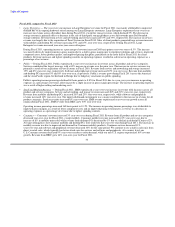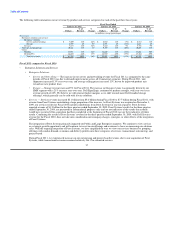Dell 2010 Annual Report Download - page 48
Download and view the complete annual report
Please find page 48 of the 2010 Dell annual report below. You can navigate through the pages in the report by either clicking on the pages listed below, or by using the keyword search tool below to find specific information within the annual report.
Table of Contents
The following table summarizes our ending cash, cash equivalents, and investments balances for the respective periods:
Fiscal Year Ended
January 28, January 29,
2011 2010
(in millions)
Cash, cash equivalents, and investments:
Cash and cash equivalents $ 13,913 $ 10,635
Debt securities 1,032 1,042
Equity and other securities 124 112
Cash, cash equivalents, and investments $ 15,069 $ 11,789
Of the $15.1 billion of cash, cash equivalents, and investments, $13.9 billion is classified as cash and cash equivalents. Our cash
equivalents primarily consist of money market funds and commercial paper. Due to the nature of these investments, we consider it
reasonable to expect that they will not be significantly impacted by a change in interest rates, and that these investments can be liquidated
for cash at short notice. Our cash equivalents are recorded at fair value.
The remaining $1.2 billion of cash, cash equivalents, and investments is primarily invested in fixed income securities, including
government, agency and corporate debt securities of varying maturities at the date of acquisition. The fair value of our portfolio is
affected primarily by interest rates more than by credit and liquidity risks. We attempt to mitigate these risks by investing primarily in
high credit quality securities, limiting the amount that can be invested in any single issuer, and investing in short -to intermediate-term
investments whose market value is less sensitive to interest rate changes. Based on our investment portfolio and interest rates at
January 28, 2011, a 100 basis point increase or decrease in interest rates would result in a decrease or increase of approximately
$4 million in the fair value of the investment portfolio.
We periodically review our investment portfolio to determine if any investment is other-than-temporarily impaired due to changes in
credit risk or other potential valuation concerns. At January 28, 2011, our portfolio included securities with unrealized losses totaling
$1 million, which have been recorded in other comprehensive income (loss), as we believe the investments are not other-than-temporarily
impaired. While these available-for-sale securities have market values below cost, we believe it is probable that the principal and interest
will be collected in accordance with the contractual terms, and that the decline in the market value is primarily due to changes in interest
rates and not increased credit risk.
The fair value of our portfolio is based on prices provided from national pricing services, which we currently believe are indicative of fair
value, as our assessment is that the inputs are market observable. We will continue to evaluate whether the inputs are market observable
in accordance with the accounting guidance on fair value measurements. We conduct reviews on a quarterly basis to verify pricing, assess
liquidity, and determine if significant inputs have changed that would impact our fair value disclosures.
LIQUIDITY, CAPITAL COMMITMENTS, AND CONTRACTUAL CASH OBLIGATIONS
Current Market Conditions
We regularly monitor economic conditions and associated impacts on the financial markets and our business. Though there was
improvement in the global economic environment during Fiscal 2011, we continue to be cautious given the volatility associated with
currency markets, international sovereign economies, and other economic indicators. We continue to evaluate the financial health of our
supplier base, carefully manage customer credit, diversify counterparty risk, and monitor the concentration risk of our cash and cash
equivalents balances globally.
We monitor credit risk associated with our financial counterparties using various market credit risk indicators such as credit ratings issued
by nationally recognized rating agencies and changes in market credit default swap levels. We perform periodic evaluations of our
positions with these counterparties and may limit exposure to any one
44
























